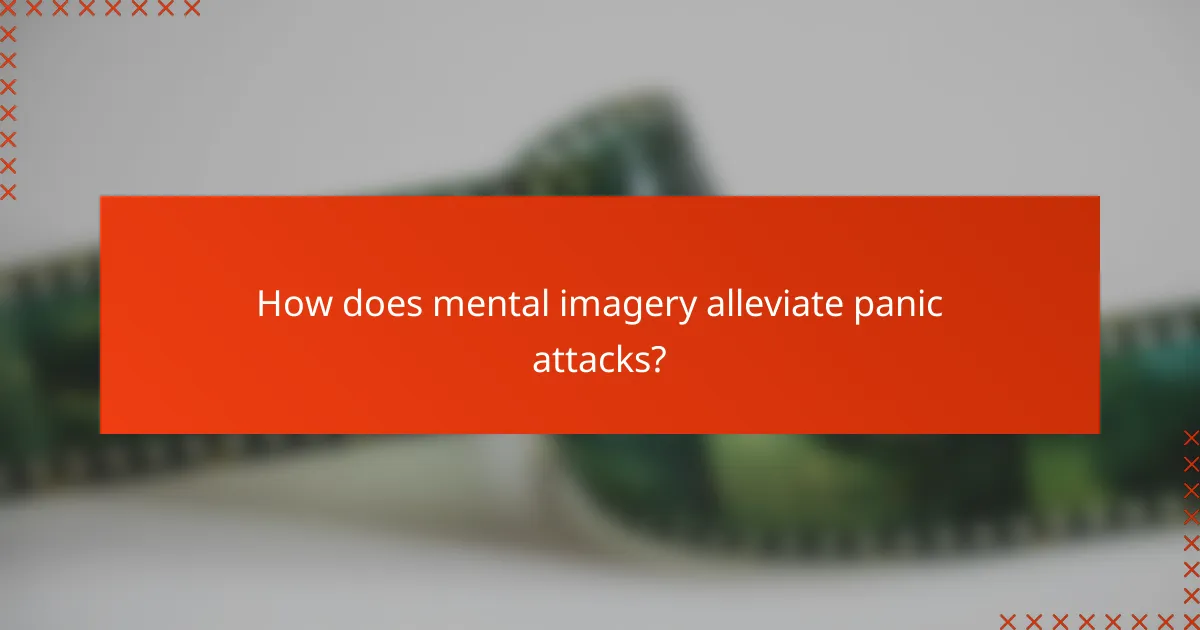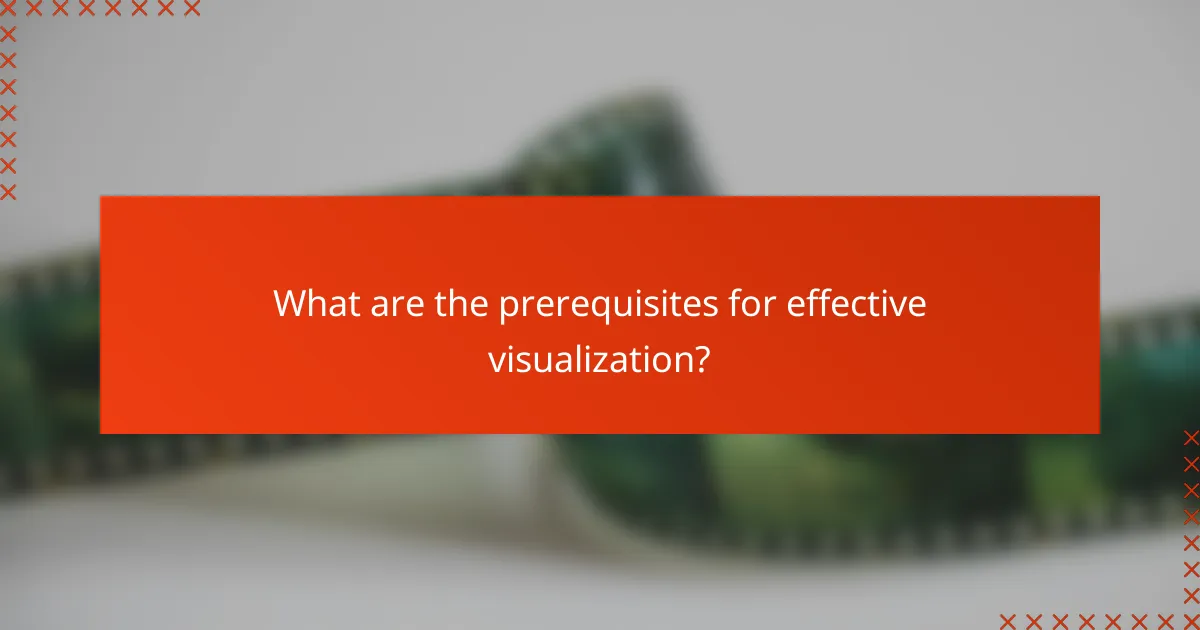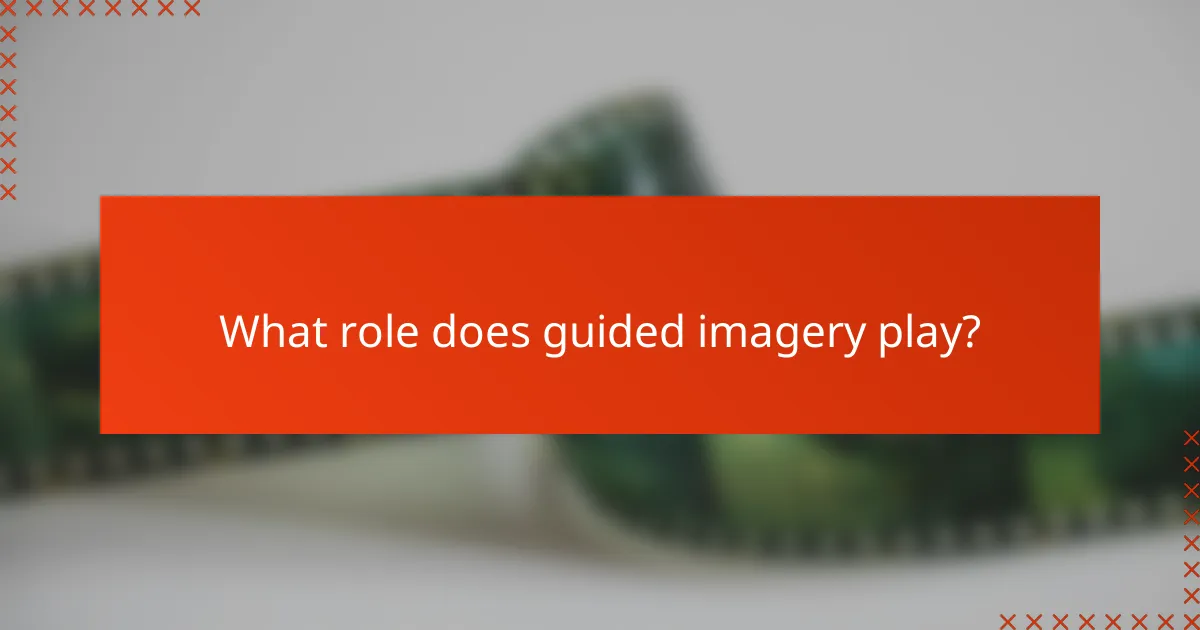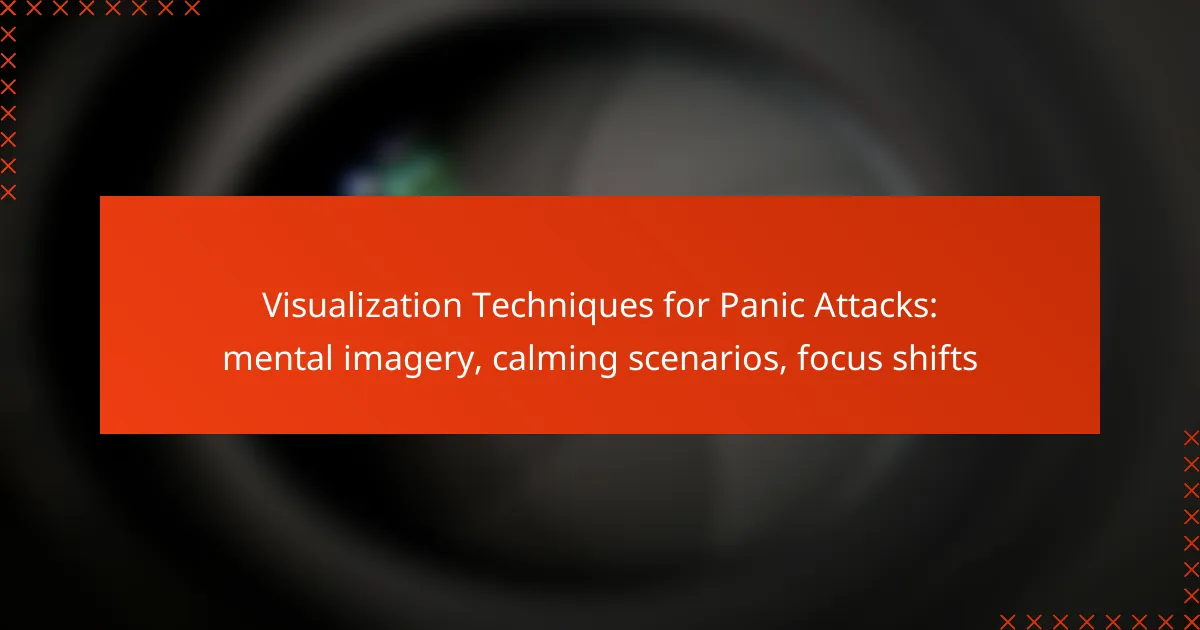Visualization techniques are powerful tools for managing panic attacks, as they guide individuals toward calming images and scenarios that promote relaxation. By engaging in mental imagery, one can effectively shift focus away from anxiety triggers, fostering a sense of safety and emotional stability. These techniques not only help reduce the intensity of panic attacks but also empower individuals to regain control over their thoughts and feelings.

What visualization techniques can help with panic attacks?
Visualization techniques can effectively reduce the intensity of panic attacks by guiding the mind toward calming images and scenarios. These methods help shift focus away from anxiety triggers, promoting relaxation and emotional stability.
Mental imagery for calming
Mental imagery involves creating vivid pictures in your mind that evoke a sense of peace and safety. This technique can be as simple as visualizing a serene beach or a quiet forest, allowing your mind to escape the immediate stressors. Engaging all your senses in this imagery—such as feeling the warmth of the sun or hearing the waves—can enhance its calming effect.
To practice mental imagery, find a quiet space and close your eyes. Take deep breaths and focus on a specific calming image, allowing yourself to immerse in the details. Aim for sessions lasting a few minutes to start, gradually increasing as you become more comfortable.
Calming scenarios in visualization
Calming scenarios involve imagining specific situations that bring you comfort and tranquility. This could include recalling a happy memory or envisioning a safe place where you feel secure. The goal is to create a mental escape that counters the feelings of panic.
When using calming scenarios, consider incorporating elements that resonate personally with you. For instance, if you find comfort in nature, visualize a peaceful hike or a quiet lakeside. Practicing this regularly can help train your mind to access these calming scenarios more easily during moments of anxiety.
Focus shifts to reduce anxiety
Shifting focus is a technique that redirects your attention from panic-inducing thoughts to more positive or neutral ones. This can be achieved through visualization, where you concentrate on calming images or scenarios instead of the panic itself. By doing so, you create a mental buffer against anxiety.
To effectively shift your focus, practice grounding techniques alongside visualization. For example, while visualizing a calming scene, you can also engage in deep breathing or count backward from ten. This multi-faceted approach can enhance your ability to manage panic attacks and reduce their frequency over time.

How does mental imagery alleviate panic attacks?
Mental imagery can significantly reduce the intensity of panic attacks by helping individuals visualize calming scenarios and shift their focus away from distressing thoughts. This technique engages the mind in a way that promotes relaxation and a sense of safety, making it easier to manage anxiety symptoms.
Imagining safe spaces
Imagining safe spaces involves creating a mental picture of a location where one feels secure and at ease. This could be a favorite room in your home, a peaceful beach, or a serene forest. By focusing on the details of this space—such as colors, sounds, and scents—you can evoke feelings of comfort and safety during a panic attack.
To practice this technique, find a quiet moment to close your eyes and visualize your safe space. Spend a few minutes exploring this environment in your mind, allowing yourself to feel the tranquility it brings. This can help ground you and reduce feelings of panic.
Creating positive mental images
Creating positive mental images involves visualizing uplifting scenarios that promote feelings of joy and relaxation. This could include recalling a happy memory, imagining a loved one, or picturing a successful outcome to a challenging situation. These images can serve as a powerful counterbalance to negative thoughts during a panic attack.
To effectively use this technique, identify specific positive images that resonate with you. Practice recalling these images regularly, so they become readily accessible when needed. Engaging with these mental pictures can help shift your focus and diminish anxiety symptoms.

What calming scenarios are effective?
Effective calming scenarios for managing panic attacks often include visualizations that evoke feelings of safety and tranquility. These scenarios can help shift focus away from anxiety and promote relaxation through mental imagery.
Nature scenes for relaxation
Visualizing nature scenes can significantly reduce stress and anxiety. Imagine a serene beach, a quiet forest, or a peaceful mountain landscape. These images can evoke calming sensations, such as the sound of waves or the rustle of leaves, which help ground you in the moment.
To enhance this technique, try to engage all your senses. Picture the colors, feel the textures, and even imagine the scents associated with these environments. This multisensory approach can deepen the relaxation experience and make it more effective.
Visualizing loved ones
Imagining loved ones can provide a strong sense of comfort during panic attacks. Visualize a family member or close friend who makes you feel safe and supported. This mental image can create feelings of warmth and connection, countering feelings of isolation often experienced during anxiety.
Consider recalling specific memories or moments spent with this person, focusing on the emotions they evoke. This technique can be particularly powerful if you include details about their appearance, voice, and the environment you shared, reinforcing the sense of security they bring.

How can focus shifts be implemented?
Focus shifts can be implemented by consciously redirecting your attention from distressing thoughts to more calming or neutral stimuli. This technique helps to interrupt the cycle of panic and anxiety, allowing for a more manageable emotional state.
Techniques for redirecting thoughts
One effective method for redirecting thoughts is to engage in mental imagery. Visualizing a peaceful scene, such as a serene beach or a quiet forest, can help shift your focus away from panic. Additionally, you can use grounding techniques, such as focusing on your surroundings and describing them in detail, to anchor yourself in the present moment.
Another approach is to practice cognitive reframing, where you consciously replace negative thoughts with positive affirmations or realistic perspectives. For example, instead of thinking “I can’t handle this,” you might tell yourself, “I have managed challenges before and can do so again.” This shift in mindset can significantly reduce feelings of panic.
Using breathing exercises
Breathing exercises are a powerful tool for implementing focus shifts during panic attacks. Techniques such as deep belly breathing can help calm the nervous system and redirect your attention to your breath. Start by inhaling deeply through your nose for a count of four, holding for a count of four, and exhaling slowly through your mouth for a count of six.
Another effective method is the 4-7-8 technique, where you inhale for four seconds, hold for seven seconds, and exhale for eight seconds. This structured breathing pattern not only helps to calm your mind but also provides a clear focus point, making it easier to shift away from panic-inducing thoughts.

What are the prerequisites for effective visualization?
Effective visualization techniques for managing panic attacks require a clear understanding of personal triggers and the ability to practice mindfulness. These prerequisites help create a conducive mental environment for calming imagery and focus shifts.
Understanding personal triggers
Identifying personal triggers is crucial for effective visualization. Triggers can vary widely among individuals and may include specific situations, thoughts, or sensory experiences. Keeping a journal to document these triggers can help in recognizing patterns and developing tailored visualization strategies.
Once triggers are identified, individuals can create mental imagery that counteracts these stressors. For example, if crowded places trigger anxiety, visualizing a serene beach or a quiet forest can provide a mental escape. This practice can help in reducing the intensity of panic responses over time.
Practicing mindfulness techniques
Mindfulness techniques enhance the effectiveness of visualization by promoting a state of calm and focus. Techniques such as deep breathing, progressive muscle relaxation, or guided imagery can ground individuals in the present moment, making it easier to engage in visualization.
Incorporating mindfulness into daily routines can be beneficial. Setting aside just a few minutes each day for mindfulness practice can improve overall emotional regulation. Simple practices like focusing on breath or observing thoughts without judgment can prepare the mind for effective visualization during moments of panic.

What role does guided imagery play?
Guided imagery serves as a powerful technique for managing panic attacks by helping individuals visualize calming scenarios that promote relaxation. This mental imagery can shift focus away from anxiety triggers, allowing for a more controlled emotional response during stressful moments.
Using apps for guided sessions
Many apps are available that offer guided imagery sessions specifically designed to alleviate anxiety and panic. These applications typically provide audio instructions and visual cues to help users immerse themselves in calming scenarios. Popular options include Calm, Headspace, and Insight Timer, which often feature sessions lasting from a few minutes to over an hour.
When selecting an app, consider user reviews and the variety of sessions offered. Look for features like customizable lengths, themes, and the ability to track progress, which can enhance the effectiveness of your practice.
Benefits of professional guidance
Working with a mental health professional can significantly enhance the effectiveness of guided imagery techniques. Therapists can tailor sessions to individual needs, ensuring that the imagery aligns with personal triggers and coping strategies. This personalized approach often leads to deeper relaxation and more effective management of panic symptoms.
Additionally, professionals can provide ongoing support and adjustments to the imagery techniques as needed. They may also incorporate guided imagery into broader therapeutic frameworks, such as cognitive-behavioral therapy (CBT), which can further improve outcomes for individuals experiencing panic attacks.

How can visualization techniques be integrated into daily life?
Visualization techniques can be seamlessly integrated into daily life by incorporating mental imagery and calming scenarios into regular routines. These practices help individuals manage panic attacks by shifting focus and promoting relaxation during stressful moments.
Establishing a routine
Creating a consistent routine for visualization can enhance its effectiveness. Set aside specific times each day, such as morning or evening, to practice mental imagery. This could involve visualizing a peaceful scene or recalling a calming memory for a few minutes.
Consider using reminders or cues throughout the day to prompt visualization. For instance, when feeling stressed, take a brief break to close your eyes and imagine a serene environment, like a beach or forest. Regular practice can help reinforce the calming effects of these techniques.
Combining with other coping strategies
Integrating visualization with other coping strategies can provide a more comprehensive approach to managing panic attacks. Techniques such as deep breathing, mindfulness, or progressive muscle relaxation can complement visualization efforts. For example, practice deep breathing while visualizing a calming scene to enhance relaxation.
Additionally, consider keeping a journal to track your experiences with visualization and other coping methods. This can help identify what works best for you and encourage a holistic approach to managing anxiety. Avoid relying solely on one method; instead, create a personalized toolkit of strategies for effective anxiety management.



